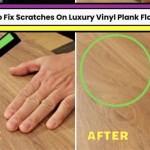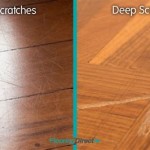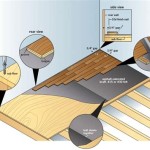How To Remove Glue From Old Vinyl Flooring
Removing old vinyl flooring glue can be a challenging and time-consuming task, often required when replacing flooring in older homes or undertaking renovations. The adhesives used to secure vinyl flooring can be incredibly tenacious, bonding strongly to both the subfloor and the vinyl itself. Understanding the types of adhesive used, the proper techniques, and the necessary safety precautions is crucial for a successful and damage-free removal process. This article provides a comprehensive guide to removing glue residue from old vinyl flooring.
Before beginning any removal process, it is essential to identify the type of adhesive used. Common adhesives include acrylic adhesives, which are generally water-based, and contact adhesives, often solvent-based. Acrylic adhesives tend to be somewhat easier to remove than their solvent-based counterparts. The age of the adhesive also plays a significant role in its difficulty of removal. Older adhesives may have hardened and become brittle over time, making them more resistant to standard removal techniques.
Safety should be a primary concern throughout the glue removal process. Many older adhesives contain volatile organic compounds (VOCs) that can be harmful if inhaled. Adequate ventilation is paramount. Opening windows and using fans to circulate air can significantly reduce exposure to harmful fumes. Wearing appropriate personal protective equipment (PPE) is also critical. This includes a respirator mask to filter out airborne particles and fumes, gloves to protect the skin from chemical exposure and physical abrasions, and eye protection to prevent debris from entering the eyes.
The condition of the subfloor is another important consideration. Many older homes have subfloors made of wood, which can be easily damaged by aggressive glue removal techniques. Concrete subfloors are generally more durable but can still be susceptible to damage from excessive scraping or the use of harsh chemicals. Careful planning and execution are necessary to minimize the risk of damaging the subfloor during the removal process.
Preparing the Area for Glue Removal
Prior to commencing glue removal, proper preparation of the work area is essential. This involves removing all remaining pieces of vinyl flooring. Even small remnants of vinyl can hinder the effectiveness of the removal process and potentially cause damage to the subfloor if caught under tools or equipment. Ensuring a clean and unobstructed work surface is the first step.
Protecting surrounding areas is also a crucial aspect of preparation. Covering nearby walls and furniture with plastic sheeting can prevent them from becoming stained or damaged by glue residue or cleaning solutions. Securing the plastic sheeting with painter's tape will ensure it stays in place during the removal process. This is particularly important when using chemical solvents, as spills and splatters can easily occur.
A preliminary cleaning of the area can also be beneficial. Vacuuming the subfloor to remove loose debris, dust, and dirt will prevent these particles from interfering with the effectiveness of the glue removal methods. A clean surface allows the chosen removal agents to penetrate the adhesive more effectively, improving their performance.
Testing the selected removal method in an inconspicuous area is highly recommended. This allows assessment of its effectiveness and potential impact on the subfloor. By observing the results in a small, hidden area, informed decisions can be made about whether to proceed with that method or explore alternative options. This prevents widespread damage or staining across the entire subfloor.
Methods for Removing Vinyl Flooring Glue
Several methods can be employed to remove glue from old vinyl flooring, ranging from mechanical techniques to chemical solutions. The best approach will depend on the type of adhesive used, the age of the glue, the type of subfloor, and personal preferences.
One of the most common methods involves using a heat gun or hair dryer to soften the adhesive. Applying heat to the glue can make it more pliable and easier to scrape away. The heat gun should be held a few inches above the glue, moving slowly back and forth to avoid overheating the surface. A putty knife or scraper can then be used to gently remove the softened glue. It is important to exercise caution when using a heat gun, as excessive heat can damage the subfloor or pose a fire hazard. Ensure proper ventilation and never leave a heat gun unattended.
Another option is to use a floor scraper, a tool specifically designed for removing flooring materials and adhesives. Floor scrapers come in various sizes and designs, ranging from handheld scrapers to larger, wheeled models. A floor scraper can be effective for removing large areas of glue, but it requires considerable physical effort. It is important to use a sharp blade and apply consistent pressure to avoid gouging the subfloor. Start with a small area and gradually work across the surface, overlapping each pass. A dust mask and safety glasses are essential when using a floor scraper, as it can generate a significant amount of dust and debris.
For more stubborn adhesives, chemical solvents may be necessary. Several commercially available glue removers are designed to dissolve or soften adhesive residue. These products typically contain solvents such as mineral spirits, acetone, or methylene chloride. It is crucial to read and follow the manufacturer's instructions carefully, as these chemicals can be hazardous if mishandled. Always use chemical solvents in a well-ventilated area and wear appropriate PPE, including gloves, a respirator mask, and eye protection. Apply the solvent to the glue and allow it to dwell for the recommended time before attempting to scrape it away. Be aware that some solvents can damage certain types of subflooring, so it is essential to test the product in an inconspicuous area first.
A less harsh alternative to commercial solvents is a mixture of vinegar and water. This solution can be effective for softening water-based adhesives. Combine equal parts of white vinegar and warm water in a spray bottle. Spray the mixture onto the glue residue and allow it to soak for 15-20 minutes. Then, use a putty knife or scraper to remove the softened glue. This method may require multiple applications, but it is a safer and more environmentally friendly option than using harsh chemicals.
Another approach involves using citrus-based cleaners. These cleaners contain natural solvents that can dissolve adhesive residue without the harsh fumes of traditional chemical solvents. Citrus-based cleaners are generally safer to use and have a pleasant odor. Apply the cleaner to the glue and allow it to dwell for the recommended time before scraping it away. As with all cleaning solutions, testing in an inconspicuous area is advisable.
Dry ice can also be used to remove adhesive, though it requires careful handling. When applied to the glue, the extreme cold causes the adhesive to become brittle and crack, making it easier to scrape away. Place small pieces of dry ice directly onto the glue residue and allow them to sublimate. Use a scraper to remove the brittle glue. Due to the risk of frostbite, it is crucial to wear thick gloves and handle the dry ice with care.
Final Cleanup and Subfloor Preparation
After removing as much of the glue residue as possible, a final cleanup is necessary to ensure a smooth and even surface for the new flooring. This involves removing any remaining traces of glue, cleaning the subfloor, and addressing any minor imperfections.
The first step is to thoroughly vacuum the subfloor to remove any loose debris, dust, and glue particles. A shop vacuum with a brush attachment is ideal for this task. Pay particular attention to corners and edges, where debris tends to accumulate. This ensures that the new flooring will adhere properly to the subfloor and avoid any bumps or unevenness.
Next, inspect the subfloor for any remaining glue residue. If necessary, use a scraper or putty knife to remove any stubborn patches. A final wipe-down with a damp cloth can help to remove any lingering traces of glue or cleaning solutions. Allow the subfloor to dry completely before proceeding to the next step.
Addressing any imperfections in the subfloor is crucial for ensuring a smooth and even surface for the new flooring. Fill any cracks, holes, or gouges with a suitable patching compound. Follow the manufacturer's instructions for mixing and applying the patching compound. Allow it to dry completely before sanding it smooth. A sanding block or orbital sander can be used to level the patched areas with the surrounding subfloor. Vacuum the subfloor again to remove any sanding dust.
Finally, apply a primer or sealant to the subfloor to improve adhesion and protect against moisture. A primer will create a better bond between the subfloor and the new flooring adhesive. A sealant will help to prevent moisture from seeping into the subfloor, which can cause mold growth and damage the flooring. Follow the manufacturer's instructions for applying the primer or sealant. Allow it to dry completely before installing the new flooring.
By following these steps diligently, the subfloor will be properly prepared for the installation of new flooring, leading to a successful and long-lasting result.

How To Remove Vinyl Flooring

How To Remove Vinyl Flooring

How To Remove Vinyl Flooring Glue

How To Remove Vinyl Flooring The Home Depot

Best Ways To Take Out Even Impossible Remove Glue From Floors

What You Should Know About Removing Old Linoleum Or Vinyl Flooring Hq Longwood Fl

Diy Vinyl Or Linoleum Flooring Removal Dumpsters Com

How To Remove Vinyl Flooring Old Linoleum Or Glue Melbourne

How To Remove Old Linoleum

The Easiest Way To Remove Vinyl Floor Tiles
Related Posts








